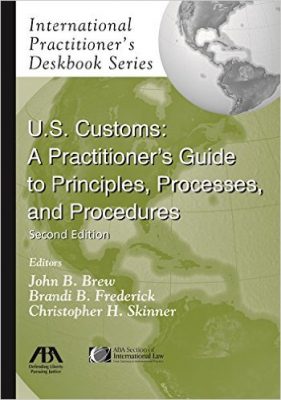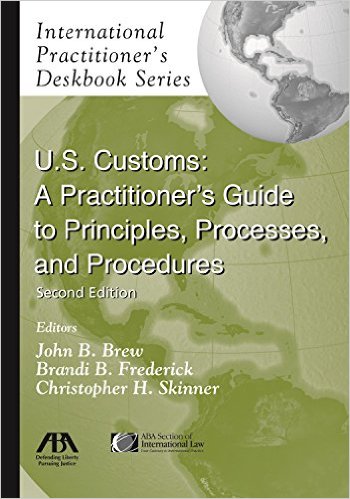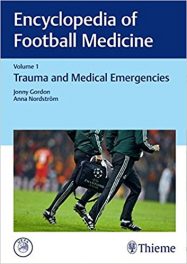 Editors: John B. Brew, Brandi B. Frederick, and Christopher H. Skinner
Editors: John B. Brew, Brandi B. Frederick, and Christopher H. Skinner
Publisher: American Bar Association – 334 pages
Book Review by: Sonu Chandiram
This is a highly important and useful book for those who are in any way involved in the business and practice of importing all kinds of goods into the United States, including of course the CEOs, partners, and employees of various import and distribution firms; bankers who issue letters of credit; customs brokers who clear goods through customs; freight forwarders who pick up and transport them; and anyone else involved in any aspect of the import process.
Being a very well organized and laid-out book, it is a valuable resource that can potentially save importers tens of thousands, and even hundreds of thousands of dollars in customs duties, and help find savings in potential penalties imposed for violations of numerous specific regulations, restrictions, and myriad rules.
Twenty-nine lawyers and other experts within the field including the three editors named above authored the 14 chapters of this great book. We name them below to give you an overview of its coverage and contents:
- Introduction and Overview
- Clearing Customs: The Importation, Entry, and Liquidation Process
- The Harmonized Tariff Schedule of the United States and Tariff Classification
- The Valuation of Imported Merchandise
- The Country of Origin of Imported Merchandise and Marking Requirements
- Duty Savings Opportunities: Introduction to Trade Agreements, Unilateral Preference Programs, and Other Duty Savings Mechanisms
- Importer Recordkeeping Obligations: What Do I Need to Keep?
- Administrative and Judicial Review of U.S. Customs and Border Protection Decisions
- Customs and Border Protection’s Examination of Importers’ Operations: The Focused Assessment
- Customs Bonds and Liquidated Damages
- S. Customs and Border Protection’s Authority to Assess Monetary Penalties
- Customs Enforcement of Other Agencies’ Regulations
- Security and Trade Facilitation
- Trusted Trader Programs
The editors – John Brew, Brandi Frederick, and Christopher Skinner – point out in their Introduction and Overview that the United States’ Customs and Border Protection (CBP) – a government agency – has evolved in its name, characteristics, duties, and roles since its inception in 1789 with the passage of the Tariff Act in the same year.
They write that this body has also adapted to numerous changes in the global trade. But its core purpose has remained the same: collection of revenue on goods coming into the country. As a matter of fact, the U.S. Customs Service was the first fully formed and the most powerful agency of the government, and its main source of revenue for about one and a quarter century, until the income tax laws were enacted in 1913.
The Tariff Act of 1789 provided the four basic elements that define customs functions, which have not changed:
- Admissibility: determines which goods may be entered into commerce in the U.S.
- Classification: assigns rate of duty owed upon importation based on product description
- Valuation (or Quantity): bases duties on products’ value or quantity, and classification
- Country of Origin: impacts both admissibility and amount of duty imposed
Several changes in import regulations and rules have also occurred since the first edition of this handbook was published in 2009. All of this is covered in this guide, which also serves as a must-have reference manual.
The second major law relating to customs duties was the Smoot-Hawley Tariff Act of 1930 that was enacted to increase revenue from customs duties, and protect local industries after the Great Depression. But its core purpose to cure the woes of that economic calamity had the opposite effect. It was later widely viewed as a failure. International trade negotiations then ensued between with many countries, tariffs were reduced, trade flourished, and the U.S. economy grew.
Ultimately the United States signed the General Agreement on Tariffs and Trade (GATT) in 1947 that effected tariff reduction globally. This was followed by the Tokyo Round in 1979 with which 102 countries came together and agreed to some $300 billion in tariff concessions. Other trade agreements have taken effect since then in which the U.S. was a signatory, and their details are covered in this book.
This is an excellent and highly authoritative handbook on United States’ import laws and regulations. The editors and authors have done impressive work to create this valuable resource. We congratulate them.
Editors and Authors:
John B. Brew is a partner in Crowell & Moring’s Washington DC office. He is vice-chair of the International Trade Group. He focuses his practice in the area of customs. He regularly advises corporations on matters involving customs administration, compliance, enforcement, legislation, litigation and policy. He represents clients in proceedings at administrative and judicial levels, as well as before Congress and international bureaucracies on customs and trade matters. He was named by Chambers USA as one of the Best Lawyers in America in International Trade.
Brandi B. Frederick is a partner in The Frederick Firm in Birmingham, Alabama. Ms. Frederick’s practice focuses primarily on labor and employment law and litigation. She obtained her Customs Broker License in 2012 and advises clients on compliance with import law and regulations, including classification with other government agency requirements. Ms. Frederick held the position of vice-chair for publications of the ABA International Law Section Committee (2013-2015) and was named one of Birmingham’s Top Women Attorneys for 2015.
Christopher H. Skinner is principal in the International Trade practice group of Squire Patton Boggs (US) LLP in Washington, DC. His practice encompasses all aspects of international trade regulation, but focuses on export controls and economic sanctions compliance, anti-corruption, and customs and import regulation. Within these areas, Mr. Skinner has extensive experience developing compliance programs, technology control plans and operating procedures, preparing voluntary and directed disclosures, obtaining export authorizations for sensitive equipment.
Contributing Authors:
John B. Brew – editor
Cyndee Todgham Cherniak
Jennifer Diaz
Brandi B. Frederick – editor
Geoffrey M. Goodale
David Grace
Bret Ian Harris
Jennifer Horvath
Christine J. Sohar Henter
Jamie A. Joiner
Jini Kohl
Marissa Mar-Jones
Christine Martinez
Christine Minarich
James Min, II
Matt Nakachi
Sarah M Nappi
Heather K. Pinnock
Robert J. Pisani
Ruta Riley
Susan Kohn Ross
Alexander H. Schaefer
Stuart P. Seidel
Christopher H. Skinner – editor
Trice Stabler
Mark Tallo
Maureen E. Thorson
George Tuttle, III
Matthew A. Vega







